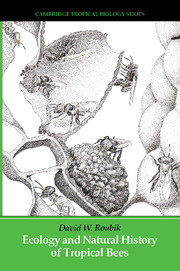Crossref Citations
This Book has been
cited by the following publications. This list is generated based on data provided by Crossref.
Kakutani, Takehiko
Inoue, Tamiji
and
Kato, Makoto
1989.
Nectar secretion pattern of the dish‐shaped flower, Cayratia japonica (Vitaceae), and nectar utilization patterns by insect visitors.
Population Ecology,
Vol. 31,
Issue. 2,
p.
381.
Engels, Wolf
and
Imperatriz-Fonseca, Vera L.
1990.
Social Insects.
p.
167.
Starr, C.K.
and
Geronimo, J.G.
1990.
Habitat and foraging observations on an oriental bumble bee (Hymenoptera Apidae).
Ethology Ecology & Evolution,
Vol. 2,
Issue. 4,
p.
373.
Winston, Mark L.
1990.
Bee Biology:
Ecology and Natural History of Tropical Bees
. David W. Roubik. Cambridge University Press, New York, 1989. x, 514 pp., illus. $69.50. Cambridge Tropical Biology Series
.
Science,
Vol. 248,
Issue. 4958,
p.
1026.
Gaston, Kevin J.
1991.
The Magnitude of Global Insect Species Richness.
Conservation Biology,
Vol. 5,
Issue. 3,
p.
283.
CAMARGO, JOÃO M. F.
and
ROUBIK, DAVID W.
1991.
Systematics and bionomics of the apoid obligate necrophages: the Trigona hypogea group (Hymenoptera: Apidae; Meliponinae).
Biological Journal of the Linnean Society,
Vol. 44,
Issue. 1,
p.
13.
Vogel, S.
and
Westerkamp, C.
1991.
Species Conservation: A Population-Biological Approach.
p.
159.
KATO, Makoto
ITINO, Takao
HOTTA, Mitsuru
and
INOUE, Tamiji
1991.
Pollination of Four Sumatran Impatiens Species by Hawkmoths and Bees..
Tropics,
Vol. 1,
Issue. 1,
p.
59.
Breed, Michael D.
and
Page, Robert E.
1991.
Intra- and interspecific nestmate recognition inMelipona workers (Hymenoptera: Apidae).
Journal of Insect Behavior,
Vol. 4,
Issue. 4,
p.
463.
SUGDEN, EVAN A.
and
PYKE, GRAHAM H.
1991.
Effects of honey bees on colonies of Exoneura asimillima, an Australian native bee.
Australian Journal of Ecology,
Vol. 16,
Issue. 2,
p.
171.
Paxton, Robert J
1991.
Profile of a Solitary Bee:Andrena Fulva.
Bee World,
Vol. 72,
Issue. 1,
p.
11.
KATO, Makoto
ROUBIK, David W.
and
INOUE, Tamiji
1992.
Foraging Behavior and Concentration Preference of Male Euglossine Bees (Apidae: Hymenoptera)..
Tropics,
Vol. 1,
Issue. 4,
p.
259.
Martin, S. J.
1992.
Colony defence against ants inVespa.
Insectes Sociaux,
Vol. 39,
Issue. 1,
p.
99.
Schneider, S. S.
and
McNally, L. C.
1992.
Seasonal patterns of foraging activity in colonies of the African honey bee,Apis mellifera scutellata, in Africa.
Insectes Sociaux,
Vol. 39,
Issue. 2,
p.
181.
Espelie, K. E.
Cane, J. H.
and
Himmelsbach, D. S.
1992.
Nest cell lining of the solitary beeHylaeus bisinuatus (Hymenoptera: Colletidae).
Experientia,
Vol. 48,
Issue. 4,
p.
414.
FIELD, JEREMY
1992.
INTRASPECIFIC PARASITISM AS AN ALTERNATIVE REPRODUCTIVE TACTIC IN NEST‐BUILDING WASPS AND BEES.
Biological Reviews,
Vol. 67,
Issue. 1,
p.
79.
Oldroyd, Benjamin
Rinderer, Thomas
and
Wongsiri, Siriwat
1992.
Pollen resource partitioning byApis dorsata, A. cerana, A. andreniformisandA. floreain Thailand.
Journal of Apicultural Research,
Vol. 31,
Issue. 1,
p.
3.
Lewis, Alcinda C.
1993.
Insect Learning.
p.
219.
Renner, Susanne S.
and
Feil, Jan Peter
1993.
Pollinators of tropical dioecious angiosperms.
American Journal of Botany,
Vol. 80,
Issue. 9,
p.
1100.
KATO, Makoto
ITINO, Takao
and
NAGAMITSU, Teruyoshi
1993.
Melittophily and Ornithophily of Long-tubed Flowers in Zingiberaceae and Gesneriaceae in West Sumatra..
Tropics,
Vol. 2,
Issue. 3,
p.
129.



